Supporting the Use of Medication in Social Care Settings Report
VerifiedAdded on 2020/07/23
|9
|2176
|36
Report
AI Summary
This report provides a detailed overview of medication use in social care settings, covering various aspects from policy and legislation to practical administration procedures. It begins by outlining relevant acts like the Medicines Act 1968 and the Health Act 2006, emphasizing the roles and responsibilities of healthcare professionals, particularly nurses, in medication management. The report then explores the importance of the Medication Administration Record (MAR) charts and the different routes and forms of medication administration, including oral, injection, and topical methods, as well as liquids, tablets, and capsules. It further details the equipment used in medication administration and data recording, including MAR charts and controlled drug registers. The report also addresses the safe storage and disposal of medications, including guidelines for cytotoxic drugs and medicine take-back programs, concluding with a summary of key points and relevant references.
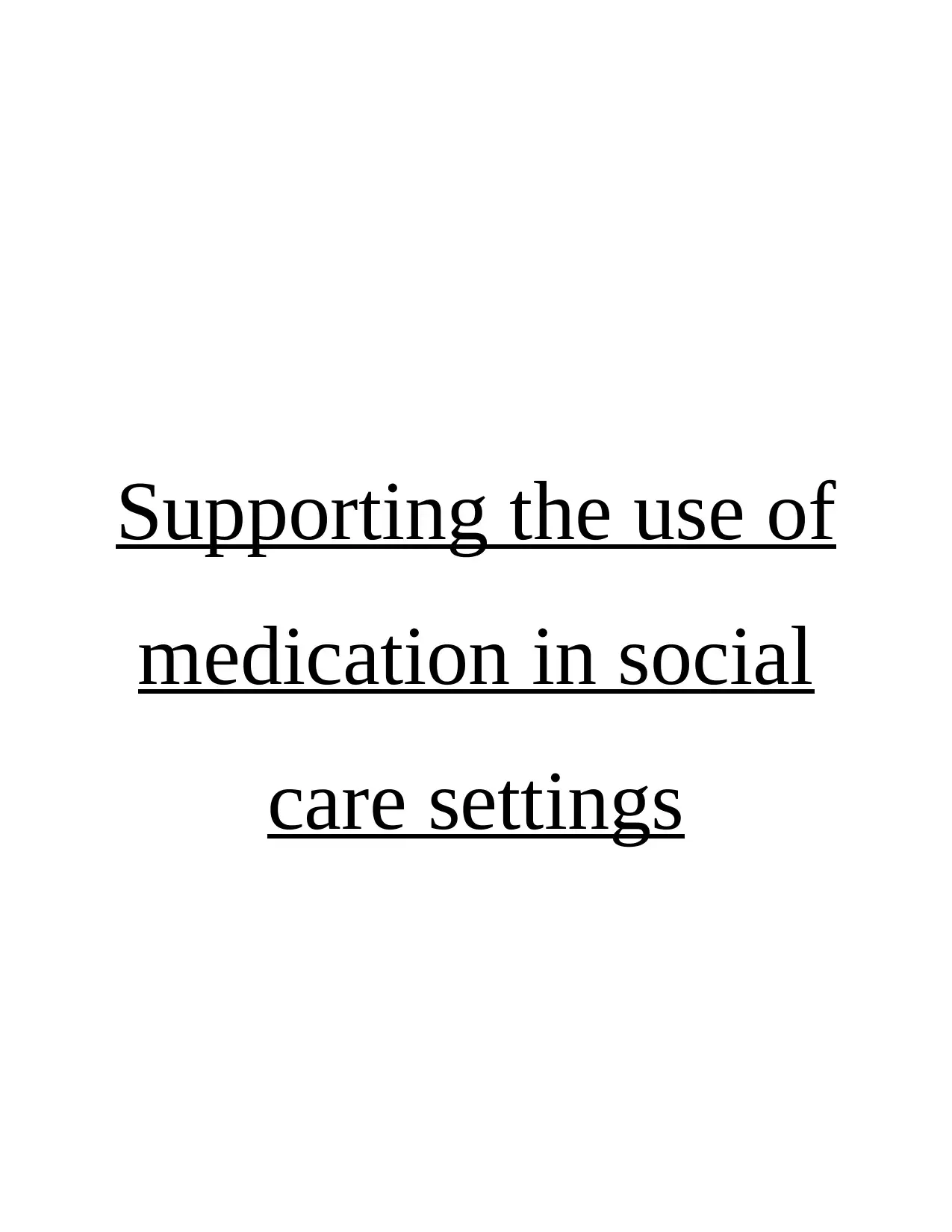
Supporting the use of
medication in social
care settings
medication in social
care settings
Paraphrase This Document
Need a fresh take? Get an instant paraphrase of this document with our AI Paraphraser
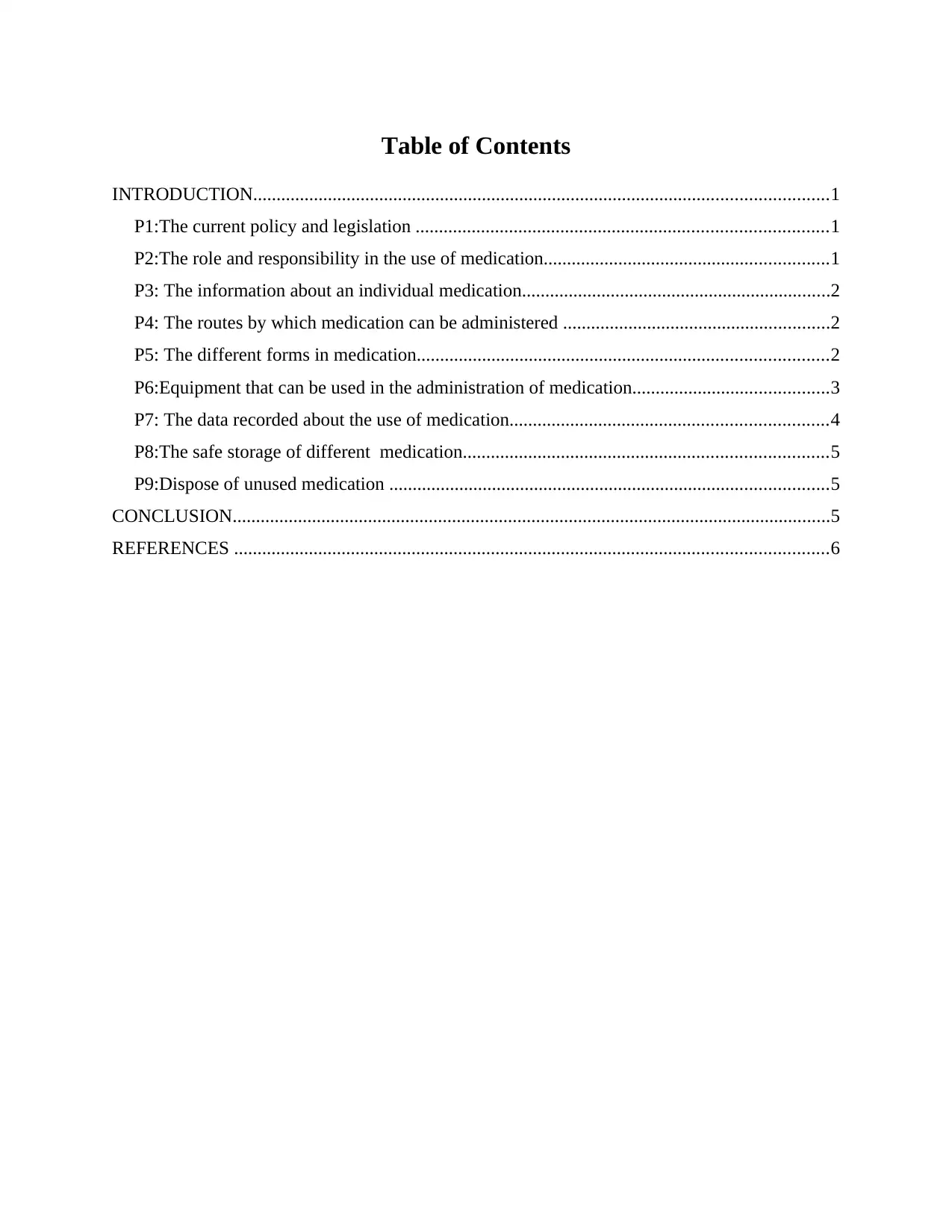
Table of Contents
INTRODUCTION...........................................................................................................................1
P1:The current policy and legislation ........................................................................................1
P2:The role and responsibility in the use of medication.............................................................1
P3: The information about an individual medication..................................................................2
P4: The routes by which medication can be administered .........................................................2
P5: The different forms in medication........................................................................................2
P6:Equipment that can be used in the administration of medication..........................................3
P7: The data recorded about the use of medication....................................................................4
P8:The safe storage of different medication..............................................................................5
P9:Dispose of unused medication ..............................................................................................5
CONCLUSION................................................................................................................................5
REFERENCES ...............................................................................................................................6
INTRODUCTION...........................................................................................................................1
P1:The current policy and legislation ........................................................................................1
P2:The role and responsibility in the use of medication.............................................................1
P3: The information about an individual medication..................................................................2
P4: The routes by which medication can be administered .........................................................2
P5: The different forms in medication........................................................................................2
P6:Equipment that can be used in the administration of medication..........................................3
P7: The data recorded about the use of medication....................................................................4
P8:The safe storage of different medication..............................................................................5
P9:Dispose of unused medication ..............................................................................................5
CONCLUSION................................................................................................................................5
REFERENCES ...............................................................................................................................6
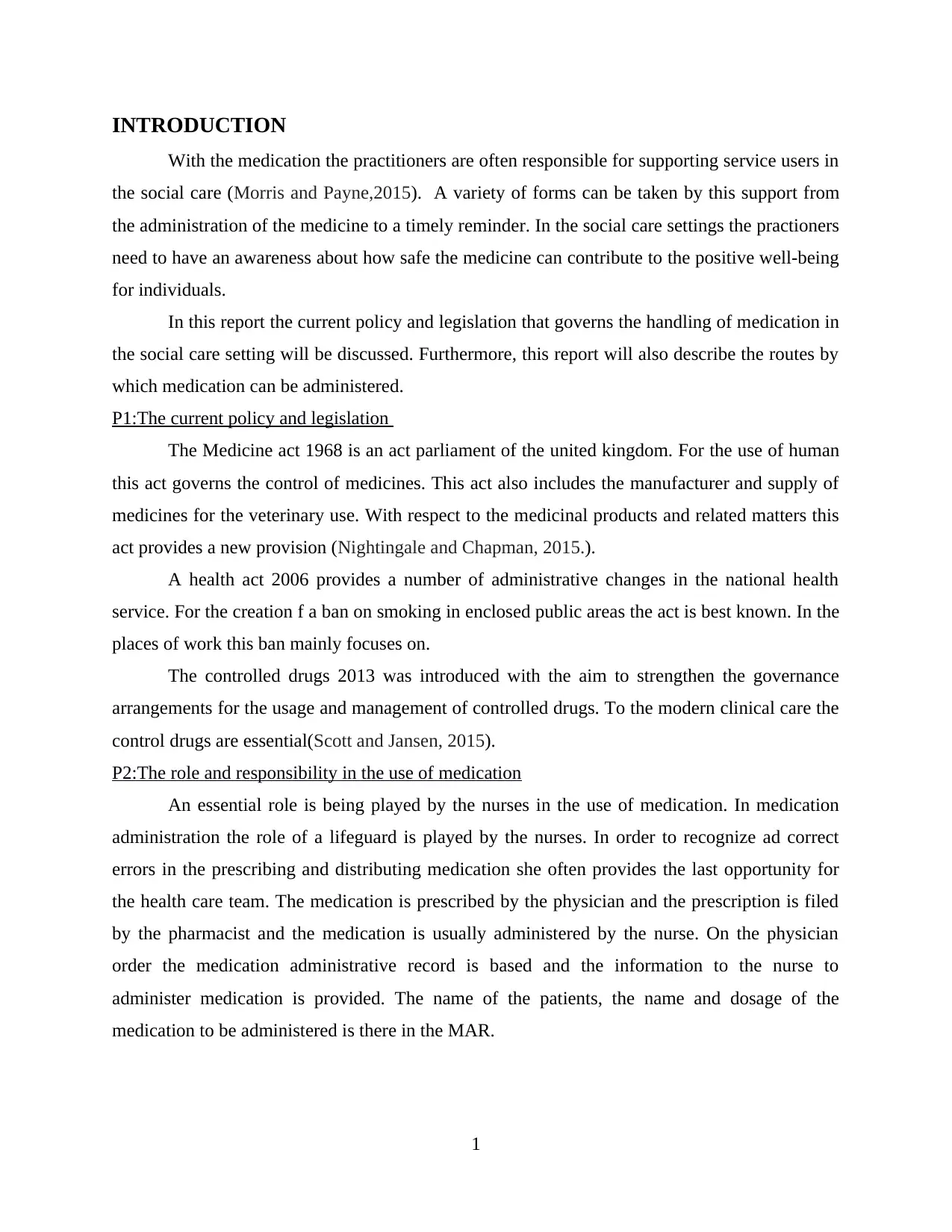
INTRODUCTION
With the medication the practitioners are often responsible for supporting service users in
the social care (Morris and Payne,2015). A variety of forms can be taken by this support from
the administration of the medicine to a timely reminder. In the social care settings the practioners
need to have an awareness about how safe the medicine can contribute to the positive well-being
for individuals.
In this report the current policy and legislation that governs the handling of medication in
the social care setting will be discussed. Furthermore, this report will also describe the routes by
which medication can be administered.
P1:The current policy and legislation
The Medicine act 1968 is an act parliament of the united kingdom. For the use of human
this act governs the control of medicines. This act also includes the manufacturer and supply of
medicines for the veterinary use. With respect to the medicinal products and related matters this
act provides a new provision (Nightingale and Chapman, 2015.).
A health act 2006 provides a number of administrative changes in the national health
service. For the creation f a ban on smoking in enclosed public areas the act is best known. In the
places of work this ban mainly focuses on.
The controlled drugs 2013 was introduced with the aim to strengthen the governance
arrangements for the usage and management of controlled drugs. To the modern clinical care the
control drugs are essential(Scott and Jansen, 2015).
P2:The role and responsibility in the use of medication
An essential role is being played by the nurses in the use of medication. In medication
administration the role of a lifeguard is played by the nurses. In order to recognize ad correct
errors in the prescribing and distributing medication she often provides the last opportunity for
the health care team. The medication is prescribed by the physician and the prescription is filed
by the pharmacist and the medication is usually administered by the nurse. On the physician
order the medication administrative record is based and the information to the nurse to
administer medication is provided. The name of the patients, the name and dosage of the
medication to be administered is there in the MAR.
1
With the medication the practitioners are often responsible for supporting service users in
the social care (Morris and Payne,2015). A variety of forms can be taken by this support from
the administration of the medicine to a timely reminder. In the social care settings the practioners
need to have an awareness about how safe the medicine can contribute to the positive well-being
for individuals.
In this report the current policy and legislation that governs the handling of medication in
the social care setting will be discussed. Furthermore, this report will also describe the routes by
which medication can be administered.
P1:The current policy and legislation
The Medicine act 1968 is an act parliament of the united kingdom. For the use of human
this act governs the control of medicines. This act also includes the manufacturer and supply of
medicines for the veterinary use. With respect to the medicinal products and related matters this
act provides a new provision (Nightingale and Chapman, 2015.).
A health act 2006 provides a number of administrative changes in the national health
service. For the creation f a ban on smoking in enclosed public areas the act is best known. In the
places of work this ban mainly focuses on.
The controlled drugs 2013 was introduced with the aim to strengthen the governance
arrangements for the usage and management of controlled drugs. To the modern clinical care the
control drugs are essential(Scott and Jansen, 2015).
P2:The role and responsibility in the use of medication
An essential role is being played by the nurses in the use of medication. In medication
administration the role of a lifeguard is played by the nurses. In order to recognize ad correct
errors in the prescribing and distributing medication she often provides the last opportunity for
the health care team. The medication is prescribed by the physician and the prescription is filed
by the pharmacist and the medication is usually administered by the nurse. On the physician
order the medication administrative record is based and the information to the nurse to
administer medication is provided. The name of the patients, the name and dosage of the
medication to be administered is there in the MAR.
1
⊘ This is a preview!⊘
Do you want full access?
Subscribe today to unlock all pages.

Trusted by 1+ million students worldwide
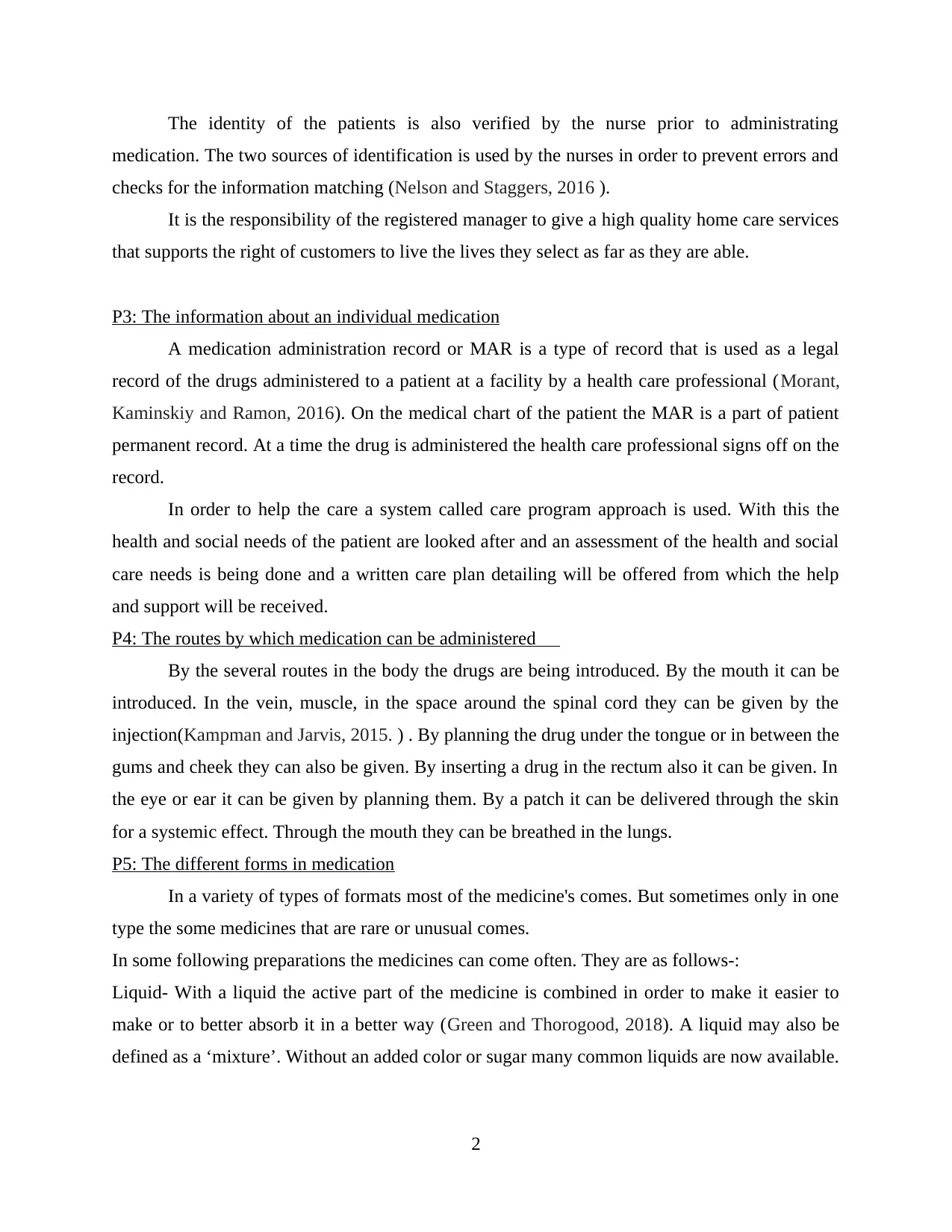
The identity of the patients is also verified by the nurse prior to administrating
medication. The two sources of identification is used by the nurses in order to prevent errors and
checks for the information matching (Nelson and Staggers, 2016 ).
It is the responsibility of the registered manager to give a high quality home care services
that supports the right of customers to live the lives they select as far as they are able.
P3: The information about an individual medication
A medication administration record or MAR is a type of record that is used as a legal
record of the drugs administered to a patient at a facility by a health care professional (Morant,
Kaminskiy and Ramon, 2016). On the medical chart of the patient the MAR is a part of patient
permanent record. At a time the drug is administered the health care professional signs off on the
record.
In order to help the care a system called care program approach is used. With this the
health and social needs of the patient are looked after and an assessment of the health and social
care needs is being done and a written care plan detailing will be offered from which the help
and support will be received.
P4: The routes by which medication can be administered
By the several routes in the body the drugs are being introduced. By the mouth it can be
introduced. In the vein, muscle, in the space around the spinal cord they can be given by the
injection(Kampman and Jarvis, 2015. ) . By planning the drug under the tongue or in between the
gums and cheek they can also be given. By inserting a drug in the rectum also it can be given. In
the eye or ear it can be given by planning them. By a patch it can be delivered through the skin
for a systemic effect. Through the mouth they can be breathed in the lungs.
P5: The different forms in medication
In a variety of types of formats most of the medicine's comes. But sometimes only in one
type the some medicines that are rare or unusual comes.
In some following preparations the medicines can come often. They are as follows-:
Liquid- With a liquid the active part of the medicine is combined in order to make it easier to
make or to better absorb it in a better way (Green and Thorogood, 2018). A liquid may also be
defined as a ‘mixture’. Without an added color or sugar many common liquids are now available.
2
medication. The two sources of identification is used by the nurses in order to prevent errors and
checks for the information matching (Nelson and Staggers, 2016 ).
It is the responsibility of the registered manager to give a high quality home care services
that supports the right of customers to live the lives they select as far as they are able.
P3: The information about an individual medication
A medication administration record or MAR is a type of record that is used as a legal
record of the drugs administered to a patient at a facility by a health care professional (Morant,
Kaminskiy and Ramon, 2016). On the medical chart of the patient the MAR is a part of patient
permanent record. At a time the drug is administered the health care professional signs off on the
record.
In order to help the care a system called care program approach is used. With this the
health and social needs of the patient are looked after and an assessment of the health and social
care needs is being done and a written care plan detailing will be offered from which the help
and support will be received.
P4: The routes by which medication can be administered
By the several routes in the body the drugs are being introduced. By the mouth it can be
introduced. In the vein, muscle, in the space around the spinal cord they can be given by the
injection(Kampman and Jarvis, 2015. ) . By planning the drug under the tongue or in between the
gums and cheek they can also be given. By inserting a drug in the rectum also it can be given. In
the eye or ear it can be given by planning them. By a patch it can be delivered through the skin
for a systemic effect. Through the mouth they can be breathed in the lungs.
P5: The different forms in medication
In a variety of types of formats most of the medicine's comes. But sometimes only in one
type the some medicines that are rare or unusual comes.
In some following preparations the medicines can come often. They are as follows-:
Liquid- With a liquid the active part of the medicine is combined in order to make it easier to
make or to better absorb it in a better way (Green and Thorogood, 2018). A liquid may also be
defined as a ‘mixture’. Without an added color or sugar many common liquids are now available.
2
Paraphrase This Document
Need a fresh take? Get an instant paraphrase of this document with our AI Paraphraser
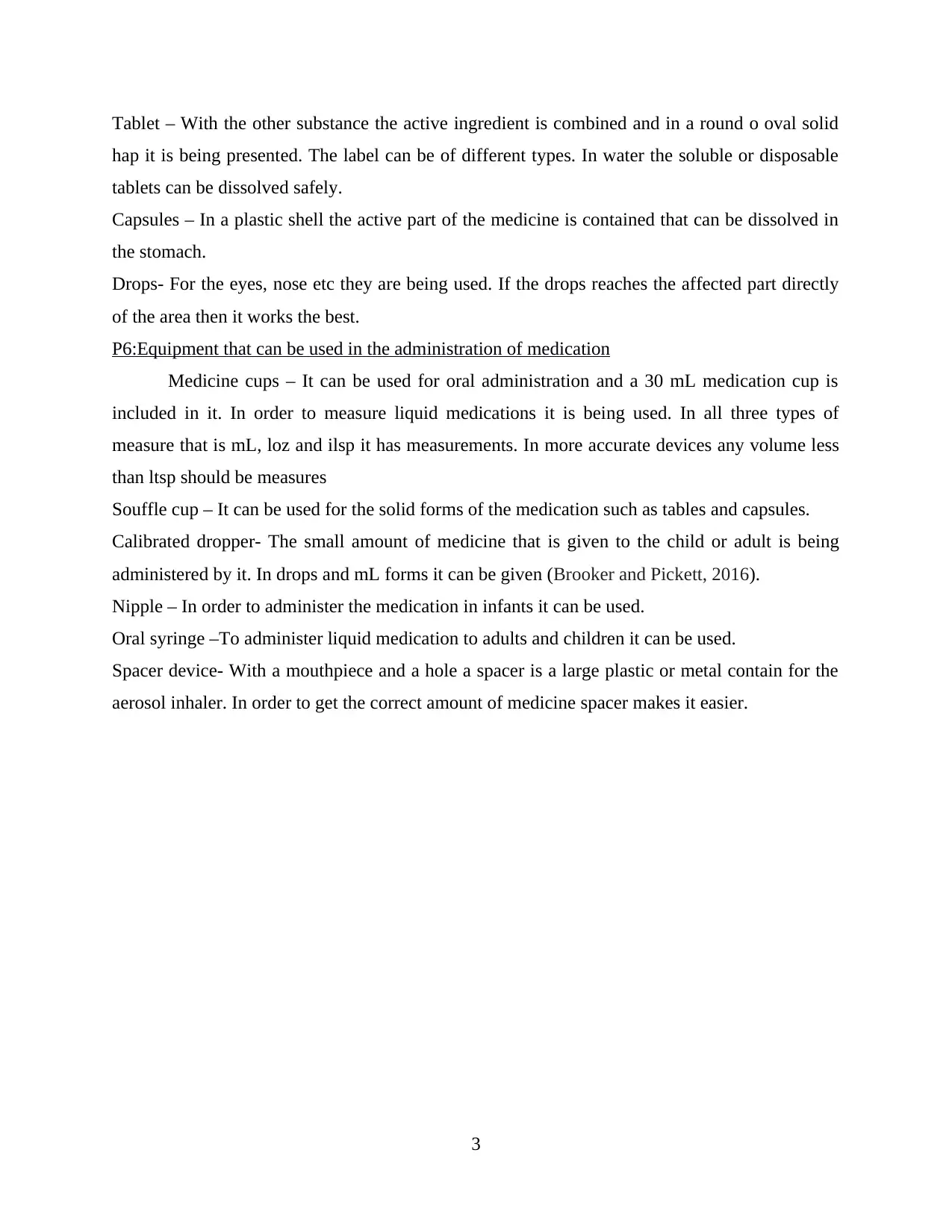
Tablet – With the other substance the active ingredient is combined and in a round o oval solid
hap it is being presented. The label can be of different types. In water the soluble or disposable
tablets can be dissolved safely.
Capsules – In a plastic shell the active part of the medicine is contained that can be dissolved in
the stomach.
Drops- For the eyes, nose etc they are being used. If the drops reaches the affected part directly
of the area then it works the best.
P6:Equipment that can be used in the administration of medication
Medicine cups – It can be used for oral administration and a 30 mL medication cup is
included in it. In order to measure liquid medications it is being used. In all three types of
measure that is mL, loz and ilsp it has measurements. In more accurate devices any volume less
than ltsp should be measures
Souffle cup – It can be used for the solid forms of the medication such as tables and capsules.
Calibrated dropper- The small amount of medicine that is given to the child or adult is being
administered by it. In drops and mL forms it can be given (Brooker and Pickett, 2016).
Nipple – In order to administer the medication in infants it can be used.
Oral syringe –To administer liquid medication to adults and children it can be used.
Spacer device- With a mouthpiece and a hole a spacer is a large plastic or metal contain for the
aerosol inhaler. In order to get the correct amount of medicine spacer makes it easier.
3
hap it is being presented. The label can be of different types. In water the soluble or disposable
tablets can be dissolved safely.
Capsules – In a plastic shell the active part of the medicine is contained that can be dissolved in
the stomach.
Drops- For the eyes, nose etc they are being used. If the drops reaches the affected part directly
of the area then it works the best.
P6:Equipment that can be used in the administration of medication
Medicine cups – It can be used for oral administration and a 30 mL medication cup is
included in it. In order to measure liquid medications it is being used. In all three types of
measure that is mL, loz and ilsp it has measurements. In more accurate devices any volume less
than ltsp should be measures
Souffle cup – It can be used for the solid forms of the medication such as tables and capsules.
Calibrated dropper- The small amount of medicine that is given to the child or adult is being
administered by it. In drops and mL forms it can be given (Brooker and Pickett, 2016).
Nipple – In order to administer the medication in infants it can be used.
Oral syringe –To administer liquid medication to adults and children it can be used.
Spacer device- With a mouthpiece and a hole a spacer is a large plastic or metal contain for the
aerosol inhaler. In order to get the correct amount of medicine spacer makes it easier.
3
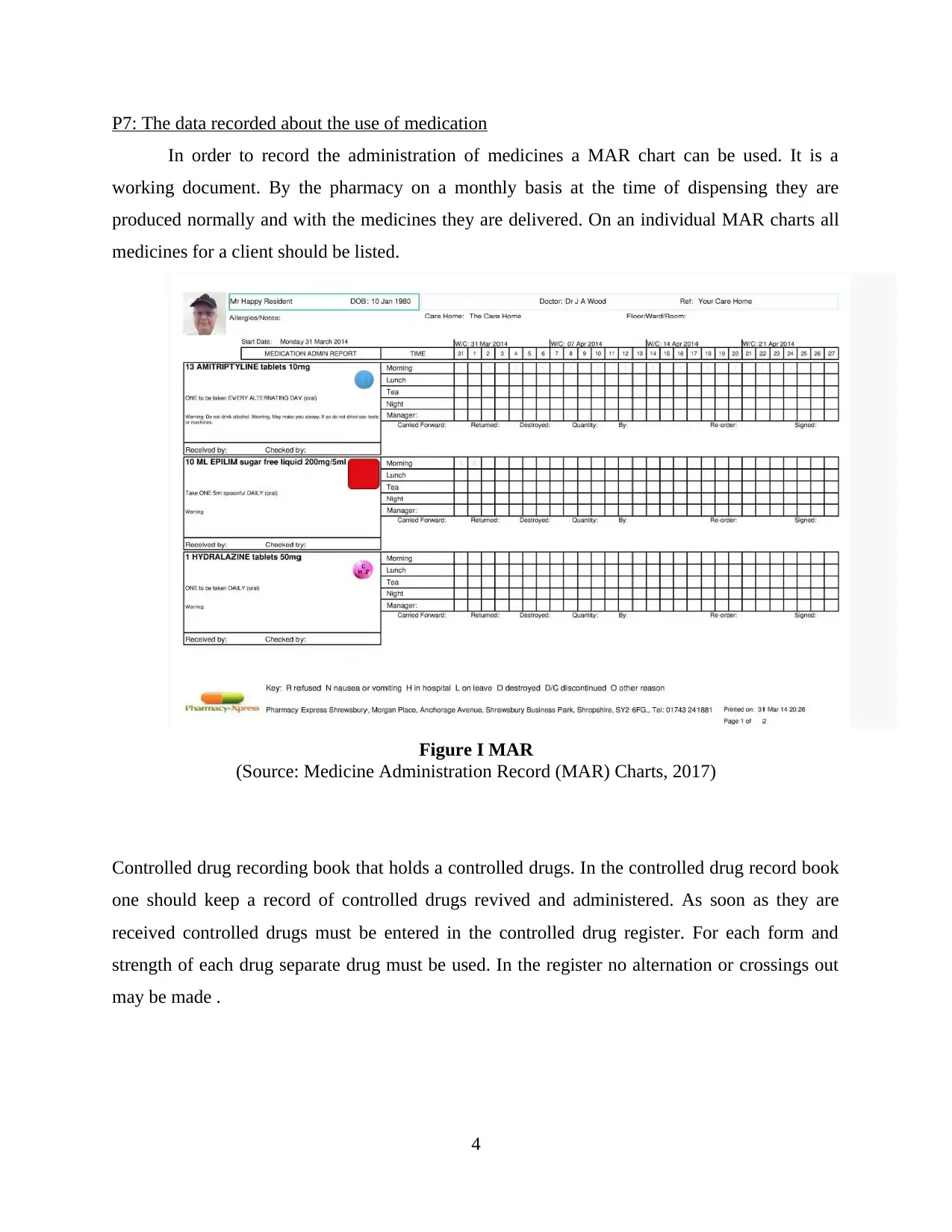
P7: The data recorded about the use of medication
In order to record the administration of medicines a MAR chart can be used. It is a
working document. By the pharmacy on a monthly basis at the time of dispensing they are
produced normally and with the medicines they are delivered. On an individual MAR charts all
medicines for a client should be listed.
Figure I MAR
(Source: Medicine Administration Record (MAR) Charts, 2017)
Controlled drug recording book that holds a controlled drugs. In the controlled drug record book
one should keep a record of controlled drugs revived and administered. As soon as they are
received controlled drugs must be entered in the controlled drug register. For each form and
strength of each drug separate drug must be used. In the register no alternation or crossings out
may be made .
4
In order to record the administration of medicines a MAR chart can be used. It is a
working document. By the pharmacy on a monthly basis at the time of dispensing they are
produced normally and with the medicines they are delivered. On an individual MAR charts all
medicines for a client should be listed.
Figure I MAR
(Source: Medicine Administration Record (MAR) Charts, 2017)
Controlled drug recording book that holds a controlled drugs. In the controlled drug record book
one should keep a record of controlled drugs revived and administered. As soon as they are
received controlled drugs must be entered in the controlled drug register. For each form and
strength of each drug separate drug must be used. In the register no alternation or crossings out
may be made .
4
⊘ This is a preview!⊘
Do you want full access?
Subscribe today to unlock all pages.

Trusted by 1+ million students worldwide
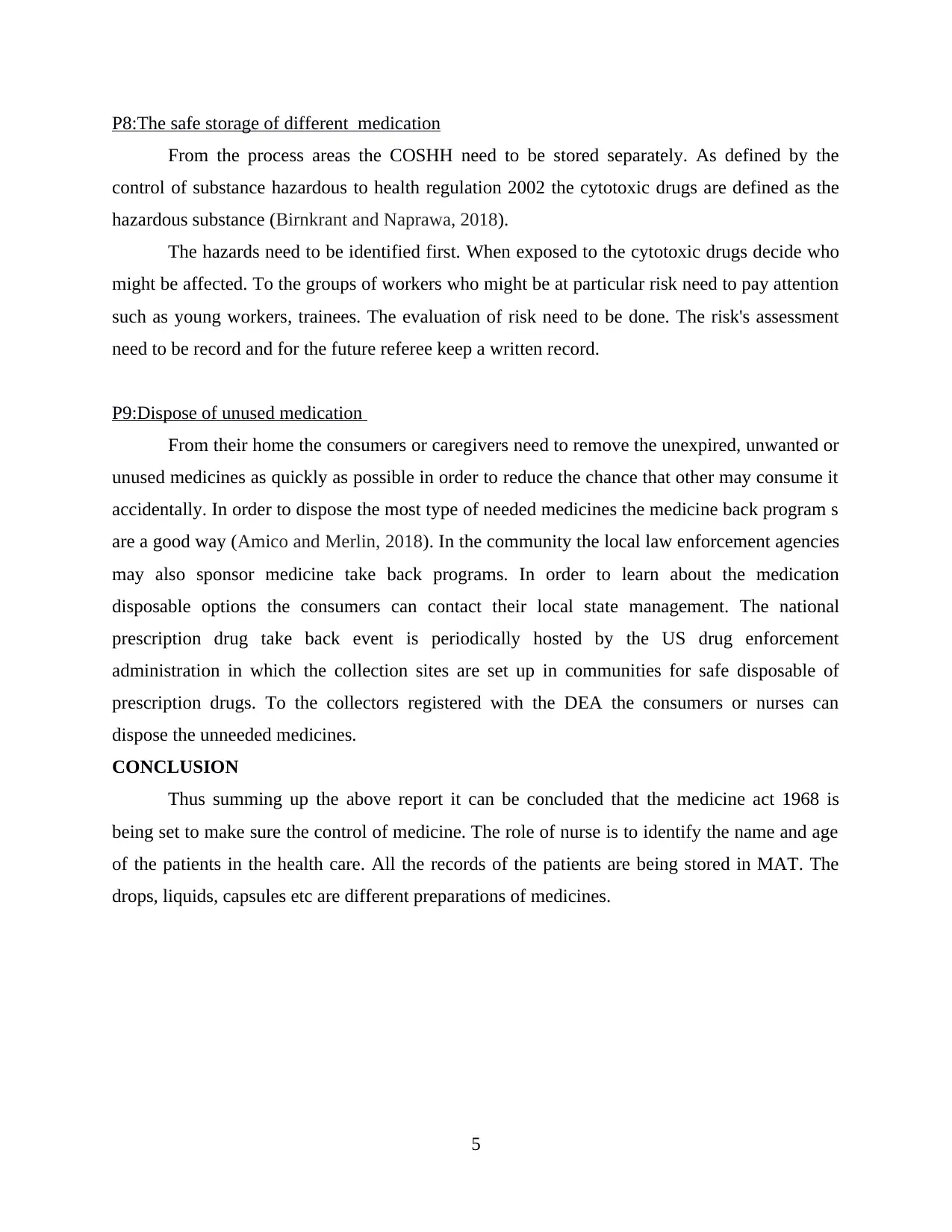
P8:The safe storage of different medication
From the process areas the COSHH need to be stored separately. As defined by the
control of substance hazardous to health regulation 2002 the cytotoxic drugs are defined as the
hazardous substance (Birnkrant and Naprawa, 2018).
The hazards need to be identified first. When exposed to the cytotoxic drugs decide who
might be affected. To the groups of workers who might be at particular risk need to pay attention
such as young workers, trainees. The evaluation of risk need to be done. The risk's assessment
need to be record and for the future referee keep a written record.
P9:Dispose of unused medication
From their home the consumers or caregivers need to remove the unexpired, unwanted or
unused medicines as quickly as possible in order to reduce the chance that other may consume it
accidentally. In order to dispose the most type of needed medicines the medicine back program s
are a good way (Amico and Merlin, 2018). In the community the local law enforcement agencies
may also sponsor medicine take back programs. In order to learn about the medication
disposable options the consumers can contact their local state management. The national
prescription drug take back event is periodically hosted by the US drug enforcement
administration in which the collection sites are set up in communities for safe disposable of
prescription drugs. To the collectors registered with the DEA the consumers or nurses can
dispose the unneeded medicines.
CONCLUSION
Thus summing up the above report it can be concluded that the medicine act 1968 is
being set to make sure the control of medicine. The role of nurse is to identify the name and age
of the patients in the health care. All the records of the patients are being stored in MAT. The
drops, liquids, capsules etc are different preparations of medicines.
5
From the process areas the COSHH need to be stored separately. As defined by the
control of substance hazardous to health regulation 2002 the cytotoxic drugs are defined as the
hazardous substance (Birnkrant and Naprawa, 2018).
The hazards need to be identified first. When exposed to the cytotoxic drugs decide who
might be affected. To the groups of workers who might be at particular risk need to pay attention
such as young workers, trainees. The evaluation of risk need to be done. The risk's assessment
need to be record and for the future referee keep a written record.
P9:Dispose of unused medication
From their home the consumers or caregivers need to remove the unexpired, unwanted or
unused medicines as quickly as possible in order to reduce the chance that other may consume it
accidentally. In order to dispose the most type of needed medicines the medicine back program s
are a good way (Amico and Merlin, 2018). In the community the local law enforcement agencies
may also sponsor medicine take back programs. In order to learn about the medication
disposable options the consumers can contact their local state management. The national
prescription drug take back event is periodically hosted by the US drug enforcement
administration in which the collection sites are set up in communities for safe disposable of
prescription drugs. To the collectors registered with the DEA the consumers or nurses can
dispose the unneeded medicines.
CONCLUSION
Thus summing up the above report it can be concluded that the medicine act 1968 is
being set to make sure the control of medicine. The role of nurse is to identify the name and age
of the patients in the health care. All the records of the patients are being stored in MAT. The
drops, liquids, capsules etc are different preparations of medicines.
5
Paraphrase This Document
Need a fresh take? Get an instant paraphrase of this document with our AI Paraphraser
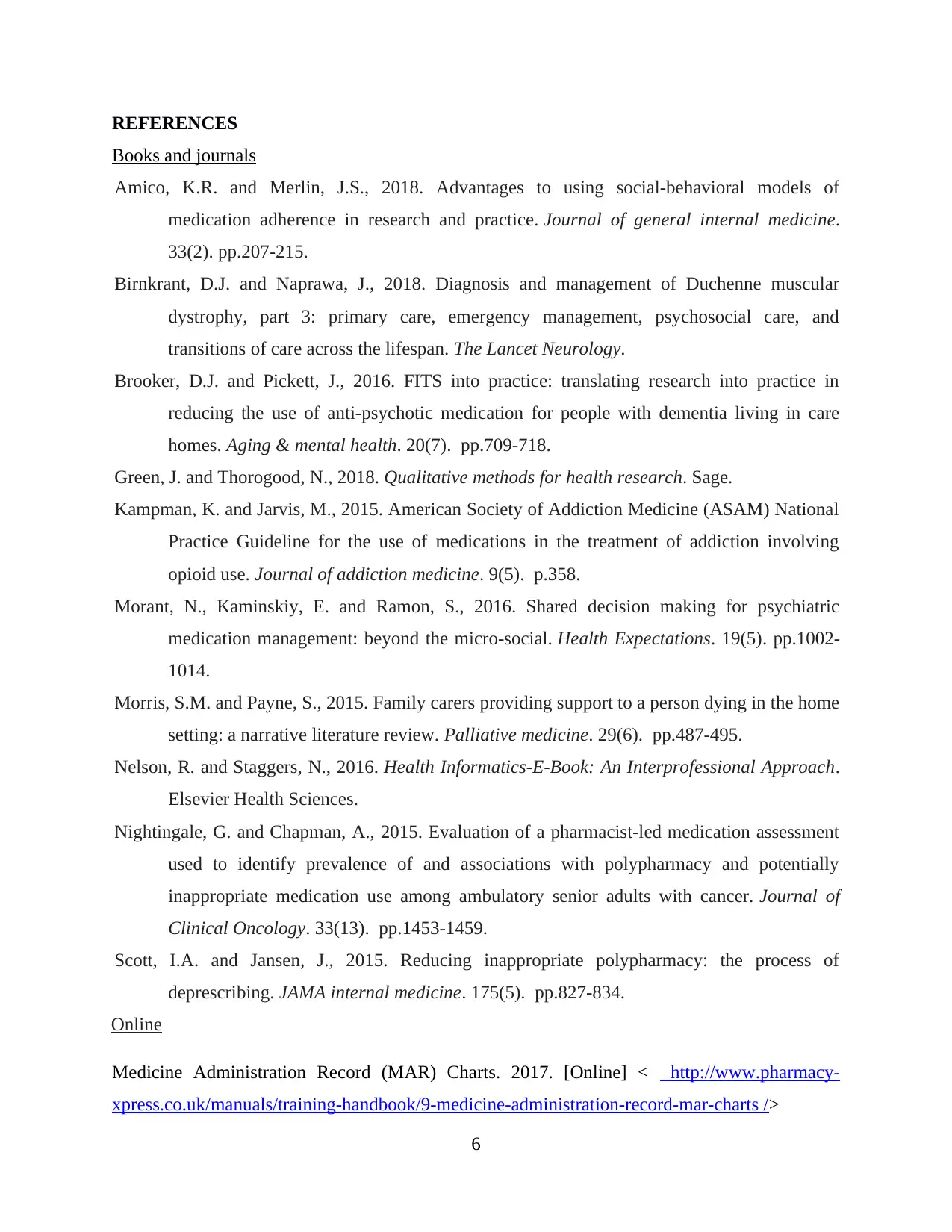
REFERENCES
Books and journals
Amico, K.R. and Merlin, J.S., 2018. Advantages to using social-behavioral models of
medication adherence in research and practice. Journal of general internal medicine.
33(2). pp.207-215.
Birnkrant, D.J. and Naprawa, J., 2018. Diagnosis and management of Duchenne muscular
dystrophy, part 3: primary care, emergency management, psychosocial care, and
transitions of care across the lifespan. The Lancet Neurology.
Brooker, D.J. and Pickett, J., 2016. FITS into practice: translating research into practice in
reducing the use of anti-psychotic medication for people with dementia living in care
homes. Aging & mental health. 20(7). pp.709-718.
Green, J. and Thorogood, N., 2018. Qualitative methods for health research. Sage.
Kampman, K. and Jarvis, M., 2015. American Society of Addiction Medicine (ASAM) National
Practice Guideline for the use of medications in the treatment of addiction involving
opioid use. Journal of addiction medicine. 9(5). p.358.
Morant, N., Kaminskiy, E. and Ramon, S., 2016. Shared decision making for psychiatric
medication management: beyond the micro‐social. Health Expectations. 19(5). pp.1002-
1014.
Morris, S.M. and Payne, S., 2015. Family carers providing support to a person dying in the home
setting: a narrative literature review. Palliative medicine. 29(6). pp.487-495.
Nelson, R. and Staggers, N., 2016. Health Informatics-E-Book: An Interprofessional Approach.
Elsevier Health Sciences.
Nightingale, G. and Chapman, A., 2015. Evaluation of a pharmacist-led medication assessment
used to identify prevalence of and associations with polypharmacy and potentially
inappropriate medication use among ambulatory senior adults with cancer. Journal of
Clinical Oncology. 33(13). pp.1453-1459.
Scott, I.A. and Jansen, J., 2015. Reducing inappropriate polypharmacy: the process of
deprescribing. JAMA internal medicine. 175(5). pp.827-834.
Online
Medicine Administration Record (MAR) Charts. 2017. [Online] < http://www.pharmacy-
xpress.co.uk/manuals/training-handbook/9-medicine-administration-record-mar-charts />
6
Books and journals
Amico, K.R. and Merlin, J.S., 2018. Advantages to using social-behavioral models of
medication adherence in research and practice. Journal of general internal medicine.
33(2). pp.207-215.
Birnkrant, D.J. and Naprawa, J., 2018. Diagnosis and management of Duchenne muscular
dystrophy, part 3: primary care, emergency management, psychosocial care, and
transitions of care across the lifespan. The Lancet Neurology.
Brooker, D.J. and Pickett, J., 2016. FITS into practice: translating research into practice in
reducing the use of anti-psychotic medication for people with dementia living in care
homes. Aging & mental health. 20(7). pp.709-718.
Green, J. and Thorogood, N., 2018. Qualitative methods for health research. Sage.
Kampman, K. and Jarvis, M., 2015. American Society of Addiction Medicine (ASAM) National
Practice Guideline for the use of medications in the treatment of addiction involving
opioid use. Journal of addiction medicine. 9(5). p.358.
Morant, N., Kaminskiy, E. and Ramon, S., 2016. Shared decision making for psychiatric
medication management: beyond the micro‐social. Health Expectations. 19(5). pp.1002-
1014.
Morris, S.M. and Payne, S., 2015. Family carers providing support to a person dying in the home
setting: a narrative literature review. Palliative medicine. 29(6). pp.487-495.
Nelson, R. and Staggers, N., 2016. Health Informatics-E-Book: An Interprofessional Approach.
Elsevier Health Sciences.
Nightingale, G. and Chapman, A., 2015. Evaluation of a pharmacist-led medication assessment
used to identify prevalence of and associations with polypharmacy and potentially
inappropriate medication use among ambulatory senior adults with cancer. Journal of
Clinical Oncology. 33(13). pp.1453-1459.
Scott, I.A. and Jansen, J., 2015. Reducing inappropriate polypharmacy: the process of
deprescribing. JAMA internal medicine. 175(5). pp.827-834.
Online
Medicine Administration Record (MAR) Charts. 2017. [Online] < http://www.pharmacy-
xpress.co.uk/manuals/training-handbook/9-medicine-administration-record-mar-charts />
6
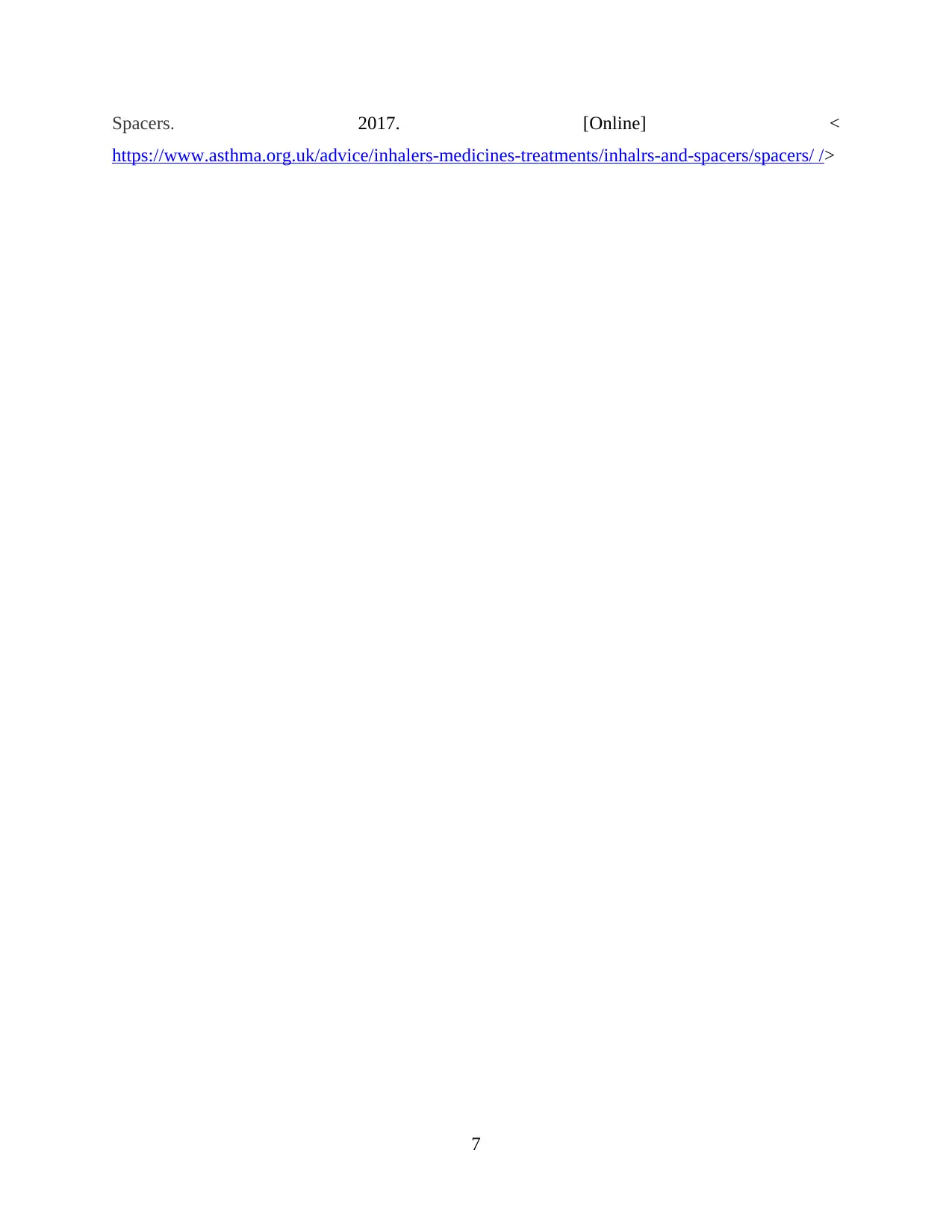
Spacers. 2017. [Online] <
https://www.asthma.org.uk/advice/inhalers-medicines-treatments/inhalrs-and-spacers/spacers/ />
7
https://www.asthma.org.uk/advice/inhalers-medicines-treatments/inhalrs-and-spacers/spacers/ />
7
⊘ This is a preview!⊘
Do you want full access?
Subscribe today to unlock all pages.

Trusted by 1+ million students worldwide
1 out of 9
Related Documents
Your All-in-One AI-Powered Toolkit for Academic Success.
+13062052269
info@desklib.com
Available 24*7 on WhatsApp / Email
![[object Object]](/_next/static/media/star-bottom.7253800d.svg)
Unlock your academic potential
Copyright © 2020–2025 A2Z Services. All Rights Reserved. Developed and managed by ZUCOL.





